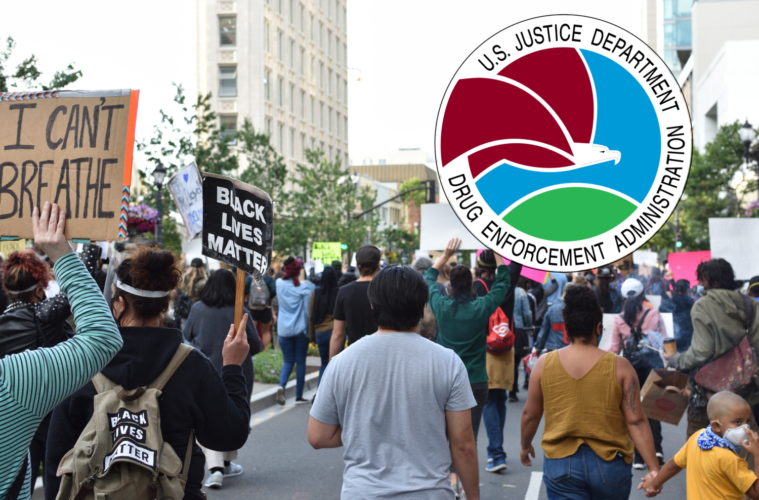Congressional cannabis leaders are pushing back against the Drug Enforcement Administration’s use of its advanced technological capabilities to participate in law enforcement responses to nationwide protests.
On Monday, Congressman Earl Blumenauer of Oregon and Congresswoman Barbara Lee of Oakland, co-chairs of the Congressional Cannabis Caucus, sent a letter Attorney General William Barr urging him to end the DEA’s surveillance of protesters marching in response to the of killing George Floyd by Minneapolis police and the deaths of other black Americans at the hands of law enforcement.
In technical terms, what specifically happened was the DEA recently received temporary approval for an expansion of their scope of enforcement priorities far beyond their designations under the Controlled Substance Act. Title 21 of the CSA is a catch-all “Control and Enforcement” section that covers everything from prescriptions to sentencing for drug crimes.
“It is our belief that this expansion of powers is inconsistent with the intents and purposes of the accessible temporary emergency powers that the agency was granted under 21 U.S.C. § 878(a)(5),” wrote the lawmakers, “Currently, tens of thousands, if not hundreds of thousands of Americans in all 50 states are exercising their rights granted under the First Amendment of the United States Constitution. At a minimum, it is inappropriate that the vast surveillance equipment the DEA has procured be utilized to discourage, monitor, and suppress those rights.”
The lawmakers emphasized their biggest concern was the DEA requesting free reign to enforce any federal law that is broken in the protests around George Floyd’s death. Acting DEA administrator Timothy Shea said the move would allow the DEA to be as helpful as possible.
“It is our concern that the use of these surveillance technologies and the tactical support of the DEA will at a minimum, further inflame the ongoing civil unrest and possibly lead to further infringements of Americans’ protected First Amendment rights by violating their Fourth Amendment rights,” the letter read.
Attorney General William Bar noted late last week the Department of Justice had activated all of its agency assets to assist with policing the ongoing demonstrations. This includes the FBI, ATF, DEA, Bureau of Prisons and U.S. Marshals Service.
“Through the FBI, U.S. Attorney’s Offices, component field offices, and state and local law enforcement, we are receiving real-time intelligence, and we have deployed resources to quell outbreaks of violence in several places,” Barr said during a press conference. “I urge governors, mayors, and other state and local leaders to work closely with the National Guard and with us. The federal government has thus far made 51 arrests for federal crimes in connection with violent rioting. We will continue to investigate, make arrests and prosecute where warranted.”
But it wasn’t just about the protests themselves. The co-chairs pointed out their concern the DEA was not explicitly barred from using the protests as cover to investigate other federal crimes that don’t have anything to do with the protests.
Another concern raised was the DEA’s history of not always having the best relationship with local law enforcement on the tactical level. The co-chairs pointed to how the DEA’s raid of Oaksterdam University in Oakland in 2012 led to a delayed police response time to a mass shooting Oikos University. Seven people were killed and three were injured.
“Furthermore, we caution against expanding the powers of the DEA. The DEA has a history of poor coordination with local enforcement and endangering the public in pursuit of violations of federal law,” the letter said. “For example, the April 2, 2012, bungled raids upon businesses operating in compliance with California law in Oakland prevented local law enforcement from responding swiftly to the Oikos University shooting.
The letter closed saying that now is the time to reevaluate the policies, procedures and limiting the scope of the mandate that Congress has assigned to the DEA. Instead, “this memo gives the DEA a free pass to run roughshod over the fundamental protections of the Bill of Rights. We strongly denounce these actions and urge you to rescind the temporary authorization permitting the DEA to conduct covert surveillance on protesters.”
But how will the DEA actually allocate resources? The 10,000 person agency is essentially half special agents and half support staff. Those staff members have access to some of the best tech money can buy when it comes to finding trends in datasets from the vast amount of metadata they are likely collecting at protests.
The DEA’s Intelligence Program is gigantic and has almost 50 years of infrastructure to fall back on in law enforcement’s quest to learn more about protesters. Worldwide, the DEA now has over 680 intelligence analysts. They are spread across a bunch of different internal groups made up of analysts and special agents. While the analysts can be found all over the world, a lot of the work is done in El Paso and the DEA Headquarters.
The program focuses on collecting three kinds of intelligence. Tactical intelligence provides information for immediate enforcement actions like arrests and seizures. Investigative intelligence is part of the wider work of dealing with multinational narcotics entities. The DEA said the final component, strategic intelligence, “focuses on the current picture of drug trafficking from cultivation to distribution that can be used for management decision making, resource deployment, and policy planning.”
Advertising disclosure: We may receive compensation for some of the links in our stories. Thank you for supporting LA Weekly and our advertisers.

